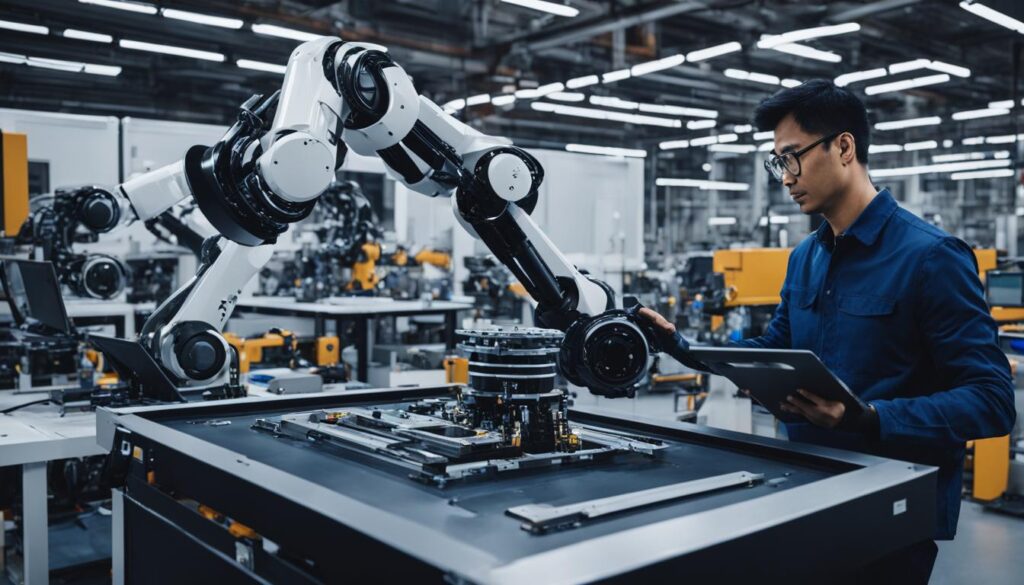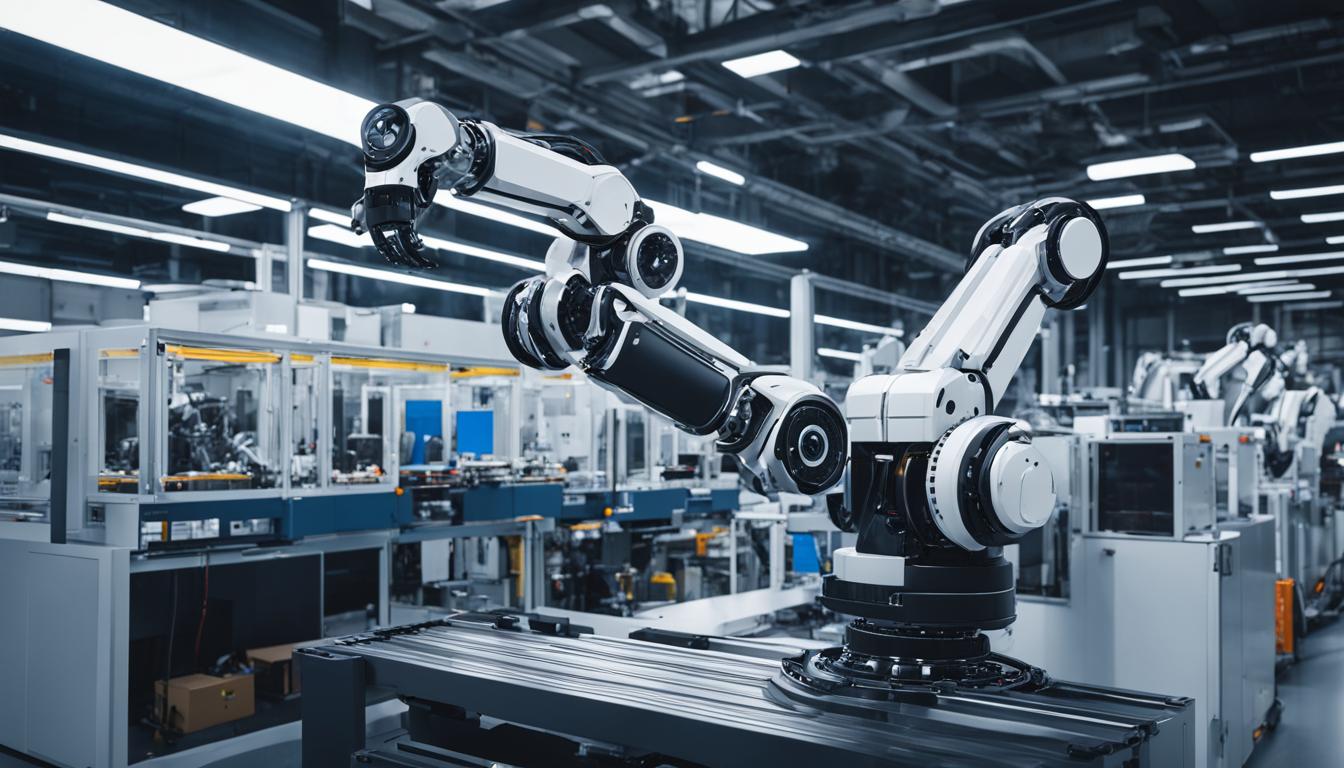Welcome to an era where artificial intelligence (AI) is revolutionizing the field of engineering. In a first-of-its-kind course offered at the NC State University Department of Mechanical and Aerospace Engineering, students showcased innovative applications of AI in engineering through their projects. Under the guidance of MAE Assistant Research Professor Veeraraghava Raju Hasti, these students explored the development of transformational digital tools and technologies using physics-based and data-driven approaches.
The projects presented at the Poster Session highlighted the incredible potential of AI in engineering. From AI-Based Manufacturing Systems to AI-generated Airfoil shapes for solar panels, these projects demonstrated how AI is shaping the future of engineering, offering immense opportunities for innovation and advancement.
Contents
Key Takeaways:
- AI is revolutionizing the field of engineering by offering innovative digital tools and technologies.
- The projects showcased at the Poster Session exemplified the diverse applications of AI in engineering.
- AI technology is transforming manufacturing systems and optimizing design processes.
- Engineers are embracing AI as a collaborative partner to push the boundaries of what’s possible in engineering.
- The potential of AI in engineering is vast, and it is shaping the future of the industry.
AI-Enhanced Design Innovation
Artificial Intelligence (AI) is driving a paradigm shift in engineering by revolutionizing design innovation. Through its advanced capabilities, AI is transforming the engineering process, resulting in AI-enhanced designs that are both efficient and effective.
One of the key contributions of AI is generative design, which leverages algorithms to automatically create and evaluate design alternatives based on specified parameters and constraints. This approach enables engineers to rapidly explore a vast range of design possibilities, allowing for greater creative freedom and optimal design selection.
Additionally, AI-powered simulations have emerged as a game-changer, enabling engineers to extensively test and analyze designs in various operating conditions without the need for physical prototypes. By simulating real-world scenarios, engineers can identify design weaknesses, optimize performance, and ensure reliability before manufacturing and production.
Furthermore, AI algorithms play a critical role in predictive maintenance, allowing engineers to proactively monitor and manage machinery and structure maintenance needs. By analyzing data from sensors and other sources, AI can predict potential failures and schedule maintenance activities accordingly. This predictive approach reduces costs, minimizes downtime, and enhances overall operational efficiency.
Through AI-enhanced design, engineers can unlock new levels of efficiency, accuracy, and speed in the engineering process. However, it is essential to note that AI is a tool that complements human expertise and creativity, rather than replacing it. The collaboration between AI and engineers is fundamental to harnessing the full potential of AI-enhanced design innovation in engineering.
AI-enhanced design innovation empowers engineers to explore creative options, virtually test designs, and proactively maintain systems. This transformative technology is revolutionizing the field of engineering.
Benefits of AI-Enhanced Design Innovation:
- Optimal design selection through generative design algorithms
- Efficient testing and analysis of designs through AI-powered simulations
- Proactive maintenance and reduced costs through predictive algorithms
- Enhanced overall operational efficiency
| AI-Enhanced Design Innovations | Benefits |
|---|---|
| Generative design | Enables exploration of multiple design options and optimal design selection based on parameters and constraints |
| AI-powered simulations | Efficiently tests and analyzes designs in various scenarios, identifying weaknesses and optimizing performance without physical prototypes |
| Predictive maintenance | Predicts machinery and structure maintenance needs, facilitating proactive maintenance and reducing costs and downtime |
With AI-Enhanced design innovation driving the future of engineering, the possibilities are vast. By leveraging the power of AI, engineers can push the boundaries of what is achievable and create solutions that are efficient, reliable, and sustainable.
The New Role of the Engineer
With AI playing a central role, the responsibilities of engineers are transforming. Engineers are no longer just implementers but also innovators and strategists, collaborating with AI to push the boundaries of what’s possible in engineering.
Utilizing AI technology, engineers have become creators of new solutions and strategies, leveraging machine intelligence to develop innovative designs and optimize performance. By working collaboratively with AI, engineers can refine designs and make informed decisions that lead to breakthrough solutions.
Ethical stewardship is also a key aspect of the engineer’s new role. As AI is increasingly deployed in design, engineers must prioritize ethical considerations to ensure that their creations meet ethical standards and societal needs. They must navigate the complex landscape of AI, ensuring that their designs align with ethical principles and contribute positively to society.
The new role of engineers combines creativity with machine intelligence, fostering a dynamic and symbiotic relationship between humans and AI. As innovators and collaborators with AI, engineers are shaping the future of engineering by harnessing the power of AI-driven technologies.

Collaborative Expertise
Engineers now have the opportunity to work hand in hand with AI technologies to achieve groundbreaking results. By leveraging AI’s computational capabilities, engineers can tackle complex design challenges and explore innovative approaches that were once unattainable. With AI as a collaborative partner, engineers can unlock new possibilities and transform ideas into reality.
“The combination of human expertise and AI capabilities has the potential to revolutionize engineering, allowing us to address complex problems more effectively and efficiently.”
—Dr. Sarah Johnson, Engineering Professor at Stanford University
The Ethical Imperative
As engineers embrace AI technologies, they must also embrace their responsibility as ethical stewards. With the power to shape the future, engineers must ensure that AI technologies are developed and used in ways that uphold ethical standards. Through thoughtful consideration of potential societal impacts and continuous evaluation of their designs, engineers can make profound contributions to society while minimizing any negative consequences.
Challenges and Opportunities
The fusion of AI and engineering design presents both challenges and opportunities. As the use of AI in engineering design becomes more prevalent, ensuring data security and privacy is crucial. With sensitive design data being processed and analyzed by AI algorithms, protecting this information from unauthorized access and breaches is of utmost importance. By implementing robust security measures and protocols, engineers can safeguard their design data and maintain the privacy of their work.
In addition to data security, engineers must also adapt to evolving AI technologies through continuous learning and training. As AI continues to advance and new tools and methodologies are developed, staying up-to-date with the latest advancements is essential. Through skills development and training programs, engineers can enhance their understanding and proficiency in AI-powered design processes, ensuring they can effectively harness the full potential of AI in their work.
“The key to success in the era of AI-driven engineering design lies in combining technical skills with the ability to navigate and implement new technologies. By embracing the opportunities presented by AI, engineers can leverage its power to design innovative and sustainable solutions.”
One significant opportunity that AI offers in engineering design is the ability to create sustainable solutions. By incorporating AI algorithms into the design process, engineers can optimize designs for energy efficiency, material usage, and environmental impact. AI-powered simulations and optimization techniques enable engineers to develop sustainable designs that minimize resource consumption and environmental footprint.
Embracing the challenges and opportunities presented by AI-driven engineering design is crucial for the future of the industry. By addressing data security concerns, continuously improving skills and training, and leveraging AI for sustainable design, engineers can drive innovation and shape a more sustainable and efficient future.
Benefits of AI in Engineering Design
When it comes to engineering design, AI offers several notable advantages:
- Efficiency: AI-powered design tools can generate multiple design variations in a fraction of the time it would take a human designer. This allows engineers to explore a broader range of options and quickly identify the most optimal designs.
- Precision: AI algorithms can analyze vast amounts of data and identify patterns and correlations that may not be apparent to human designers. This enables engineers to make data-driven decisions and create designs with higher levels of precision and performance.
- Creativity: AI’s ability to generate designs based on specified parameters opens up new avenues for creativity. Engineers can input constraints and requirements, allowing AI to generate innovative design solutions that may not have been considered otherwise.
These benefits, combined with the challenges and opportunities discussed earlier, demonstrate the transformative potential of AI in engineering design.
Comparison of AI-Driven and Traditional Engineering Design
| AI-Driven Design | Traditional Design | |
|---|---|---|
| Speed | Faster design iteration and optimization process. | Time-consuming iterative design process. |
| Efficiency | Efficient generation of design variations. | Reliance on human designers for exploring design options. |
| Precision | Data-driven decision-making for precise design solutions. | Reliance on experience and intuition for decision-making. |
| Creativity | AI-generated designs push the boundaries of creativity. | Dependent on human creativity and expertise. |
The table above provides a comparison between AI-driven design and traditional design, highlighting the advantages offered by AI in terms of speed, efficiency, precision, and creativity.
Conclusion
The future of engineering is undergoing a remarkable transformation with the emergence of artificial intelligence (AI). Thanks to AI-driven design innovations, such as generative design and simulation testing, the engineering process is being revolutionized. Engineers are embracing new roles as innovators, collaborators with AI, and ethical stewards, ushering in a new era of possibilities.
While challenges like data security and skills training are present, engineers have the opportunity to design for a sustainable future. By harnessing the power of AI-driven innovations, engineers can develop environmentally conscious solutions that meet ethical standards and address societal needs.
As AI continues to advance, the potential for engineering knows no bounds. By leveraging the capabilities of AI, engineers can push the boundaries of what’s possible and shape the future of the industry. The future of engineering lies in embracing the transformative power of AI and its endless possibilities for innovation and progress.
FAQ
How is artificial intelligence (AI) transforming the field of engineering?
AI is revolutionizing engineering by enhancing design innovation, allowing engineers to generate multiple design variations and simulate and analyze designs virtually. AI also predicts maintenance needs, enabling proactive maintenance and reducing costs and downtime.
What role do engineers play in AI-driven design?
Engineers are no longer just implementers but also innovators, collaborating with AI to develop new solutions and strategies. They prioritize ethical considerations to ensure designs meet ethical standards and societal needs.
What challenges and opportunities exist in AI-driven engineering?
Challenges include ensuring the security of sensitive design data and continuously learning and adapting to evolving AI technologies. However, engineers also have the opportunity to design with environmental sustainability in mind.
How is the emergence of AI reshaping the future of the engineering industry?
AI-driven design innovations, such as generative design and simulation testing, are revolutionizing the engineering process. Engineers are taking on new roles as innovators, collaborators with AI, and ethical stewards, shaping the future of the industry.




